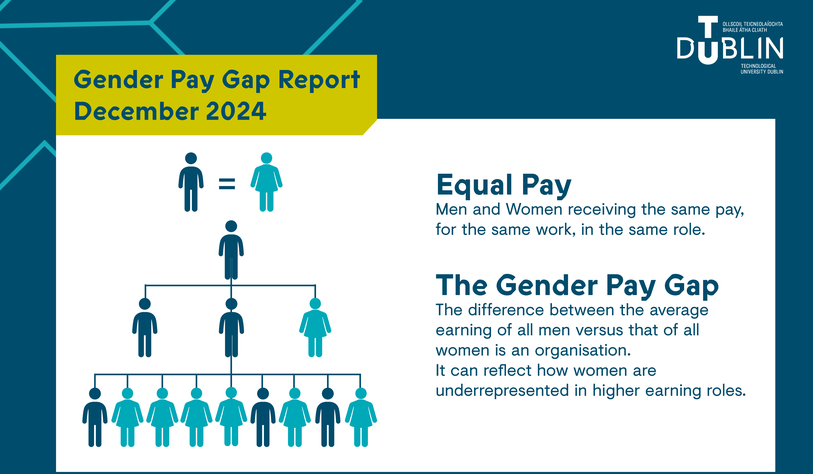TU Dublin Gender Pay Gap Report
In line with the Gender Pay Gap Information Act 2021, TU Dublin published its Gender Pay Gap Report 2024 in December 2024.
The Gender Pay Gap is an equality measure that shows the difference between the average earnings of all men versus that of all women in an organization.

Read TU Dublin's Gender Pay Gap Report 2024.
Quartiles
The % of male employees and the % of female employees in
- the lower remuneration quartile pay band
- the lower middle remuneration quartile pay band
- the upper middle remuneration quartile pay band
- the upper remuneration quartile pay band
The Mean Pay Gap
The mean hourly wage for women is calculated by adding all rates of pay for female employees together and dividing by the total number of female employees in an organisation. The same is then done for all male employees in the organisation. The mean gender pay gap is the difference between women’s mean hourly wage and men’s mean hourly wage.
The mean includes all of the lowest and highest rates of pay, and therefore can reflect the impact of a higher proportion of women working in lower paid roles, and a higher proportion of men in higher paid roles.
The Median Pay Gap
The median gender pay gap is the difference between women’s median hourly wage (the middle paid woman) and men’s median hourly wage (the middle paid man). The median hourly wage is calculated by ranking all employees from the highest paid to the lowest paid, and taking the hourly wage of the person in the middle.
What is equal pay?
Equal pay is the legal obligation that requires employers to give men and women equal pay for like work. Paying women less than men for the same job, purely on account of their gender, is illegal and is outlawed by equality legislation.
What is the difference between the gender pay gap and equal pay?
Men and women are paid equal pay for like work by law in Ireland.
However if there are significantly more women than men in lower earning roles in an organisation, then women’s hourly average pay will be lower than men’s hourly average pay in that organisation – this is the gender pay gap.
If women on average earn less than men, the percentage is expressed as a positive figure. For example, in Ireland women on average earn 14.4% less than men, so the pay gap is 14.4%.
What is the difference between the mean and the median pay gaps?
The mean pay gap is calculated by adding all female and male employees’ rates of pay respectively and dividing by the total number of female and male employees respectively.
International measures also use the mean when calculating the pay gap, which enables comparisons to be made with other countries.
The median pay gap is calculated by finding the midpoint in all female and male employees’ hourly pay respectively and discarding the lowest and highest rates. Often, a median pay gap will be lower than its corresponding mean pay gap.
What are the causes of the gender pay gap in Ireland?
Causes of the gender pay gap in Ireland include:
- women’s disproportionate responsibility for unpaid care work and high cost of childcare in Ireland
- occupational segregation - this is the clustering of women and men into:
- different types or work, also called horizontal segregation - e.g. a lot of women in childcare and a lot of men in technology and engineering
- different levels of work, also called vertical segregation – e.g. more men than women in senior management roles
- a lack of quality part-time and flexible working;
- the economic undervaluation of stereotypical female work such as care, retail, administration and cleaning;
- discrimination and bias such as unclear recruitment, development and progression practices
If you have any questions, please contact equality@tudublin.ie.
